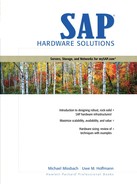Summary
Even the lowest bandwidth provided by modern LAN technologies will be sufficient for relatively high numbers of SAP users. However, because SAP is competing for bandwidth with other applications, including SAP's own new mySAP.com components and solutions, the result is a need for high-performance local area networks. The reliability and the total-cost-of-ownership considerations must also be taken into account.
Here is a summary of the basic recommendations for mission-critical SAP LAN infrastructures:
Replace proprietary, terminal infrastructure with a TCP/IP-enabled network.
Consider a migration from a Token Ring to an Ethernet bandwidth hierarchy.
Consider a migration from FDDI to a switched Ethernet bandwidth hierarchy.
Deploy high-speed technologies within the SAP server network in the data center.
Avoid protocol conversion between LAN segments.
Replace hubs by switches—fully switched is better than fast shared.
Reduce broadcast overhead wherever you can.
Employ switches wherever you can, route where you must.
Limit the number of network protocols—be as mono-protocol as possible.
Restrict flat multi-protocol networks to a maximum of 300 nodes.
Restrict flat mono-protocol networks to a maximum of 500 nodes.
Deploy automatic broadcast control and layer-3 switch filtering mechanisms to prevent non-SAP traffic reaching application servers.
Avoid Spanning Tree.
Deploy LAN cluster concepts.
Consider uninterruptable power supplies for all networking cabinets.
